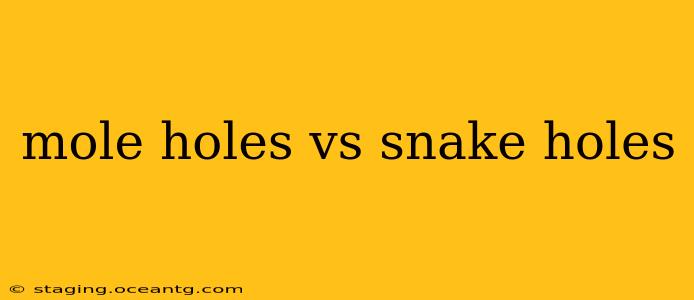Discovering holes in your garden can be unsettling. Are they the work of industrious moles, or something more sinister like a snake? Knowing the difference is crucial for choosing the right control methods and protecting your plants and pets. This guide will help you distinguish between mole holes and snake holes, offering insights into their characteristics and behaviors.
What Do Mole Holes Look Like?
Mole holes are typically small, irregularly shaped mounds of freshly turned earth, often appearing in clusters. They're a result of moles tunneling just beneath the surface, pushing soil upwards as they create their underground networks. You'll rarely see a distinct entrance hole like you might with a snake. Instead, the soil is pushed up in a haphazard manner, creating small, volcano-like mounds. These mounds often lack a central opening and are usually found in areas with soft, easily worked soil.
How are mole tunnels different from other tunnels?
Mole tunnels are often quite extensive and interconnected, forming a complex underground network. They aren't straight lines but rather a series of winding passages. This extensive network allows moles to quickly traverse their territory searching for food (insects, grubs, and earthworms).
What Do Snake Holes Look Like?
Snake holes are usually much more subtle than mole holes. They are often just a simple, often oval-shaped, entrance hole in the ground, usually near a sheltered area like a rock, log, or dense vegetation. The surrounding soil may be slightly disturbed, but there won't be the characteristic mounds of freshly turned earth associated with mole activity. The hole may be larger and more irregular than a mole hole, and sometimes you might even see a snake entering or exiting the burrow.
What kinds of snakes might I find in my garden?
The type of snake using the hole will depend on your geographical location and habitat. Some common garden snakes are harmless and beneficial to the ecosystem, controlling rodent populations. However, always exercise caution and never handle a snake unless you are certain of its species and are experienced in handling reptiles.
Are there any other animals that might create holes in my garden?
Yes! Several other animals can create holes that might be mistaken for mole or snake holes. These include:
- Voles: These small rodents create shallow, often interconnected tunnels, leaving behind small piles of soil similar to moles but usually smaller and less noticeable.
- Groundhogs (Woodchucks): These much larger rodents create extensive burrow systems with larger, more obvious entrances.
- Squirrels: Depending on the species, squirrels might dig shallow holes for burying nuts or creating temporary nests.
How can I tell the difference between mole and snake activity?
The key differences lie in the type of soil disturbance:
- Moles: Create numerous small mounds of freshly turned earth with no visible entrance hole.
- Snakes: Create a single, relatively unobtrusive hole with minimal soil disturbance.
It's also important to consider the location and surrounding environment. Moles prefer areas with soft soil, while snakes might choose locations near cover or water sources. Observing the area carefully, noting the size and shape of the holes, and any other signs of animal activity, can help you identify the culprit.
What should I do if I find mole or snake holes in my garden?
Whether you're dealing with moles or snakes depends largely on your comfort level and local regulations. Some people find mole tunnels unsightly, while others appreciate their role in aerating the soil. Snakes, on the other hand, can be more concerning, depending on the species present. If you're unsure about identification or feel uncomfortable, contacting a local wildlife expert or pest control service is always recommended.
By carefully observing the characteristics of the holes and considering the surrounding environment, you can effectively distinguish between mole holes and snake holes, allowing you to take appropriate action. Remember, many animals play a vital role in the ecosystem, so responsible management is key.
